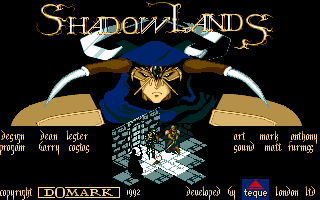From The CRPG Addict
Shadowlands
United Kingdom
Teque London (developer); Domark Software (publisher)
Released in 1992 for Amiga, Atari ST, and DOS
Date Started: 2 October 2018
Some of the games we’ve seen on my blog are timeless. They may have been developed 30 years ago or more, but they still appear on lists of games you have to play before you die. They’re still enormously fun today, and not just in a retro way. I live for those games, and particular for finding ones that you didn’t know about. That’s only happened a few times.
Then there are the opposites: games that simply were never destined to age well. Those that should have been forgotten a few years after their release, only this is the Internet Age, when nothing is ever forgotten. Almost invariably, such titles depend largely on technological ideas that seemed brilliant and innovative at the time, but that are hopelessly old-fashioned by now. Shadowlands is the perfect example of this latter type of game. It has a few elements that were at least unusual, if not unique, for its day, and those are certainly worth a mention. But it’s not 1992 anymore, and if your entire raison d’etre was dynamic lighting, you simply didn’t have a long shelf life.
Shadowlands‘ very title is a nod to its primary innovation. The torches the characters carry cast pools of light in a radius around them. The pool stops at obstacles. The lighter is brighter nearer the character and dimmer farther away. The pool travels with the character and thus changes the effective color of the ground and wall tiles as the party moves. As the torch burns, the glow dims and eventually fades away entirely, leaving the characters in the dark if they don’t constantly replenish their light sources by grabbing torches from sconces on the wall.
 |
| Dynamic lighting is the game’s primary innovation. |
These effects are so expected today that I had to read from other pages that Shadowlands did anything innovative in this regard. I mean, I guess I’ve never seen lighting effects exactly like this before, but certainly we’ve had some precursors. Way back in 1982, Dungeons of Daggorath simulated dwindling torches by having the very surroundings fade from view–and that was with wireframes. Ultima V and VI had the visible screen shrink at night and realistic line-of-sight. I can think of a number of games with torches or fireplaces that flicker and glow during cut scenes. This entire topic would make for an interesting special post some day, but honestly I’d have to go back and review games to research it, because until they get really good in the 2000s, marginal increases in lighting effects simply aren’t something that you’re likely to notice today. I’m compelled to note that Shadowlands‘ effects, however innovative, are still limited to illuminating a “radius” of square tiles rather than individual pixels. I don’t say this to detract from the programming effort that went into it, but simply to suggest that you shouldn’t try to build an entire game around a bit of technology that, while innovative, is also destined to be temporary. After the initial “huh” reaction, if you notice it at all, you’re left with an annoying game that makes you micro-manage torches.
Shadowlands‘ second innovation is, alas, less obviously brilliant and basically sinks my enjoyment of the game. The idea must have seemed so brilliant when it came to whatever developer insisted on it. “Game interfaces are so
complicated,” he must have said. “There’s too much stuff to
memorize. Why not make it easier? You want the character to walk? Click on his legs! You want him to pick up stuff? Click on his hand! What could be more obvious?” And hence we have this game’s interface, where each character is controlled by clicking on body parts and then the appropriate part of the map. To pick up a weapon on the ground, you click on the character’s right hand and then the weapon. To read something, you click on his head and then the thing you want to read.
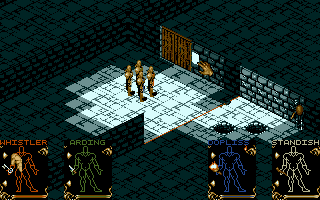 |
| To open this door, I put the key in my hand, activate my hand, and click on the keyhole. |
While I grant that I’ve never quite seen this approach before, a few things ought to have occurred to the developers. First, as obvious as it is to click a head to read and a hand to pick up, since you can’t read weapons and you can’t pick up signs, they could have saved a lot of trouble by just having you click on the object directly and had the game perform basically the only action you can perform with that object. There’s nothing to do with a skeleton except to attack him. Why do I have to click on my left hand first?
Second, there’s a difference between “easy to master” and “easy to play.” This is a lesson that every developer who insisted on a mouse-only interface needed to learn. Yes, I picked up the interface in seconds. That still doesn’t make it any less annoying than to have to click on a leg to walk, then walk to the torch, then click on the hand, then click on the torch. It would have been better to give me keyboard shortcuts for the type of action and leave the mouse for the location of the action.
I don’t know why developers of this era hated the keyboard so much. They must have seen it as an artifact of the 1980s. Maybe some of them got irked at having to play the Ultima games with a reference card next to them. What they forgot is that once you had played for about an hour, you’d memorized the commands on that reference card, and then you never had to think about the interface again. You played a game with the same facility that I just typed this sentence. That’s a measure of a good interface. I know–and thank the gods this is true–that by the late 1990s, developers smartened up and stated pairing the mouse and keyboard as equal partners. Until then, a lot of these games are going to be tough to get through.
Beyond the mouse-only problem, the game’s interface fails in a lot of other areas. You can’t just click to walk across a room; the game won’t let you click too far away from the character, and thus you have to mince across the landscape. You’re limited to movement horizontally or diagonally by tiles, as if there’s an invisible chessboard underneath the terrain, so the characters never take direct paths, nor can they walk through places that look like they have obvious gaps. And when the four characters move together, they get hung up on
everything. You’re constantly having to send the lead character back to pick up stragglers and to micro-manage their steps through doorways and around corners. To say that pathfinding is poor is to erroneously suggest that it has any at all.
 |
| One character got left int he dark on the edge of a narrow doorway. |
When you get past these issues, you’re left with a typical British isometric puzzle-oriented game, the kind that premiered (apparently) in Knight Lore (1984), was made famous by Cadaver (1990), and acquired RPG status in Legend (1992) and now Shadowlands. The RPG elements are quite light. Characters have attributes and combat and magic levels that apparently increase through successful combat. Combat offers no real tactics.
Shadowlands‘ well-written backstory tells of the conquering of the peaceful nation of Koranos by the hordes of Cthul Tol Anuin, the undead Overlord from the Shadowlands. Koranos’s Prince Vashnar was killed by the Overlord personally, but only after a disturbing episode in which his wife Tianna was raped by a fire demon and eventually succumbed to her consequent injuries. In his dying hour, Vashnar swore to take vengeance on the Overlord.
Now in the nearby Harbour Lands, adventurers of all kinds have been experiencing dreams of the fall of Koranos from various perspectives, including Vashnar’s. These dreams are a call to action. Eventually, four of them accept the quest to venture to the Shadowlands, retrieve Vashnar’s bones, and resurrect him on an altar in the Overlord’s temple so he can fulfill his vow.
Every party consists of four characters–a warrior, a magician, a priest, and an orc. Each has preset values in combat ability, magic ability, strength, and health. You can “reroll” these, but there’s a maximum value for the total ability score, so if you reroll better strength, you’ll lose it in less health (or something else). You get to customize facial features for each character, with separate options for hair, eyes, nose mouth, and chin. While this is perhaps a “first,” the only time the character portraits appear in the game is if the characters separate from each other.
 |
| The limited party-creation screen. |
As you can see, the artwork is Japanese-inspired, credited to graphic designer Mark Anthony, “a fan of all things Japanese.” The title screen is accompanied by an appropriate pentatonic composition. These themes don’t really extend beyond the title screen and character portraits, however.
Gameplay begins in a small outdoor area. You can move characters independently or as a party, split parties, and ultimately get your characters quite far afield from each other. I’m sure that various puzzles will eventually require it.
Characters start with no inventory, but there are apples lying around the wilderness, plus a couple of sticks and one bow you can use as starting weapons. It’s particularly important to pick up any food you see because you fight a constant battle with food and water meters. There are non-hostile crows flitting about. You can kill them, but I don’t know if it helps your statistics. The leveling system is rather opaque, consisting only of a magic and combat level that occasionally increases behind the scenes.
A sign confirms that we’re in “The Shadowlands”–I guess that’s its official name, and not just some kind of nickname bestowed by its enemies. A nearby graveyard is marked with a sign calling it the “Field of the Fallen Heroes.” Just north of that is a stairway down into a dungeon, where I’m guessing the rest of the game will be spent.
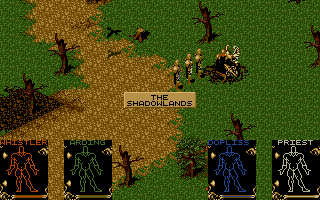 |
| Nice to know I’m in the right place. |
The first level of the dungeon had all the hallmarks of an introductory level, with lots of items to find and mostly-easy puzzles and enemies. It took me about an hour to get through the first time, learning the game’s conventions, and about 40 minutes the second time. I chose to restart because the first time, I didn’t realize that unless you purposefully extinguish them, torches continue to burn in your backpack, and thus no matter how many you pick up, you might reach the end of the level with no light.
Obstacles consisted of a few keyed doors, one door that required weighing down a pressure plate with an object, a door that opened with a hidden switch, one door that required each character to stand on a different plate, and one door that opened when a torch was dropped in front of some kind of statue.
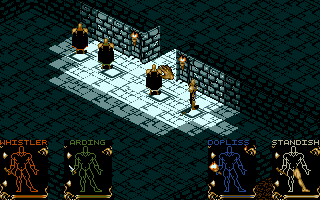 |
| Each character had to stand on a different plate to open this door. |
The game quickly introduced a convention by which puzzles are preceded with coin slots in the wall. You can drop a variety of coins (found in the dungeon) into these slots to get signs with hints to pop up on nearby walls. The plaque next to the puzzle that required a torch in front of the statue, for instance, read “alight here to reach your next stop.” The clue to hold down a pressure plate was “weight and see.”
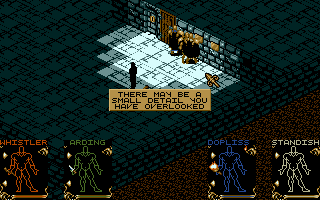 |
| A hint alerts me to a hidden button nearby. |
The level had a handful of patrolling skeletons. Most of them left me alone until I got very close. Fighting in Shadowlands requires you to click on a character’s left hand–ideally holding a weapon–and then click on the enemy. The problem is if the enemy is in motion, it can be tough to get your click in the right spot. And if you want all characters to attack you have to repeat this for each character. (There’s a pause function, but you can’t issue orders during it.) Enemies and characters pound away at each other until dead. Health regenerates reasonably fast after combat, so it’s individual battles you have to worry about, not the accumulation of them.
 |
| Preparing to attack a skeleton. |
The first few skeletons were quite easy, but I encountered some towards the end of the level that I couldn’t defeat without dying. I can technically walk past them, but skeletons often drop useful or even necessary stuff (like keys), and I’m worried I might miss something essential by leaving them alive.
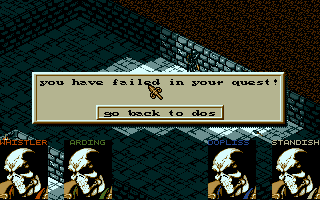 |
| The full-party death screen. |
I accumulated a lot of torches and apples on the first level, plus three flasks that I filled with water at the many fountains (you can also drink directly from fountains). I suspect food, water, and light will be scarce on lower levels. I don’t just suspect it, actually–the game documentation warns you of it. Theoretically, you could get through a level in the dark, I think, but you wouldn’t be able to read anything and it would be hard to see items on the floor. It already is, even with light.
The game’s magic system involves collecting and casting spells from scrolls. Scrolls can be assembled into magic books. Each scroll or book has a fixed amount of magic force, which is depleted when you cast a spell. In an interesting innovation, you regain magic force by draining it from everyday objects like sticks and food (which makes the object less effective) and then channeling it into the book or scroll. It thus makes sense to thoroughly drain objects before discarding them. I’ve only found one scroll so far, so I haven’t really had a chance to explore the system.
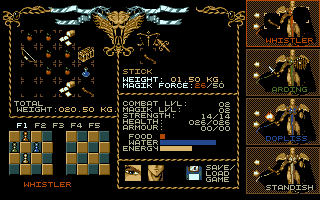 |
| This stick has 26 “force points” that I can transfer to my “Energy” bar. |
All told, Shadowlands is a game with some interesting ideas, but the nature of the interface and the blunted combat system are going to make a long game tough to tolerate. I’ll give it at least a few more dungeon levels, partly because I want to see how the puzzles grow in difficulty. Up next, it’s long past time to check in with Crusaders of the Dark Savant.
Time so far: 3 hours
Original URL: http://crpgaddict.blogspot.com/2018/10/game-305-shadowlands-1992.html











